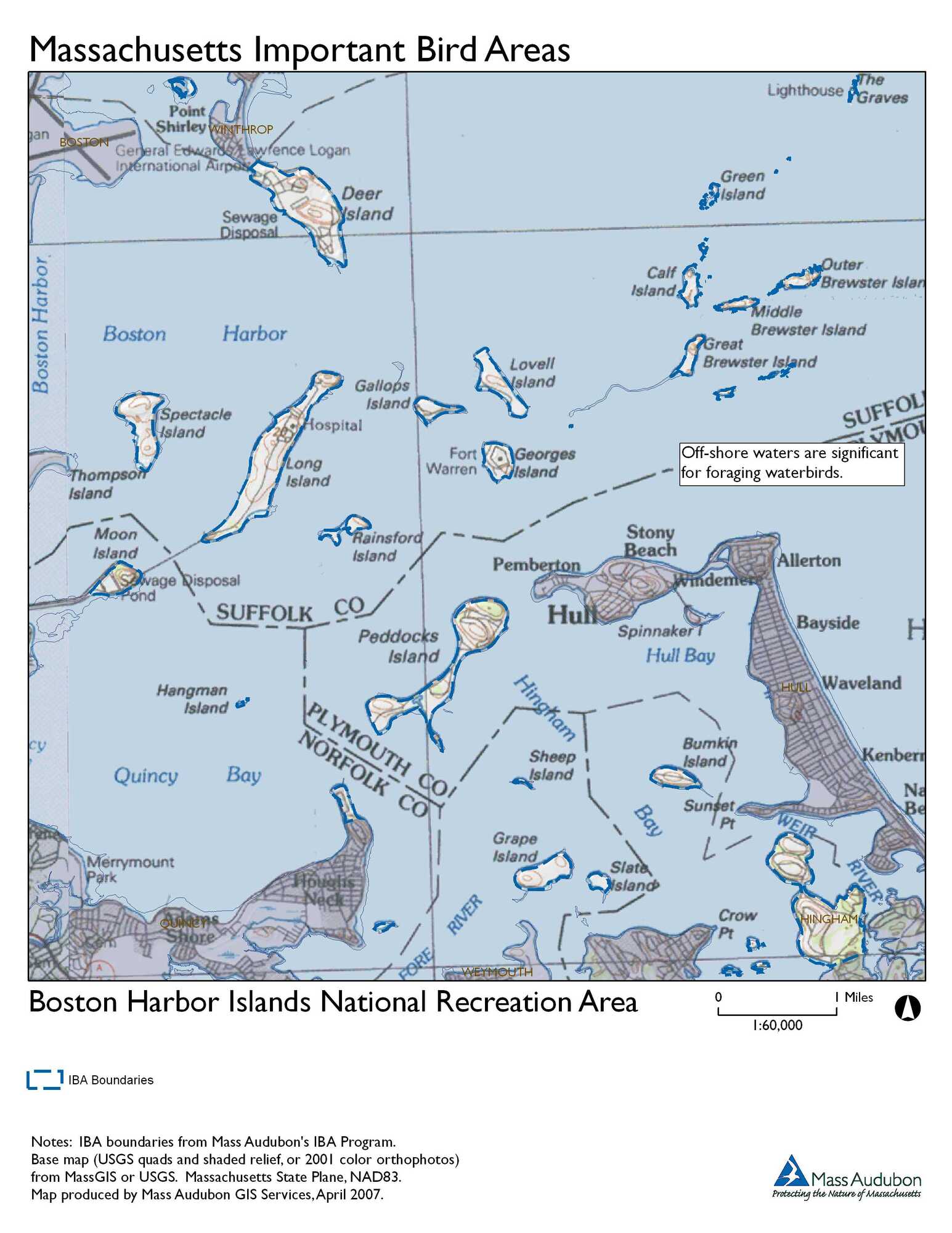BHI--Little Brewster Island
BHI--Little Brewster Island
Boston Harbor Islands Official WebsiteBoston Harbor Islands (National Park Service) webpage
Boston Harbor Islands map
Boston Harbor Islands National Recreation Area IBA
About this Location
This bedrock outcropping is one of the Brewsters, a group of the outermost islands in the park. It is an active Coast Guard navigational aid facility, so the buildings are not open to the casual visitor and there are no public restrooms on the island. A carry-in/carry-out policy applies to all trash.
This two-acre island is best known as the home of Boston Light, the country’s oldest continually used lighthouse site (1716). Originally financed by a tax of a penny-a-ton on all vessels entering and leaving the harbor, the stone lighthouse was largely destroyed by the British when they evacuated Boston at the close of the Revolutionary War but was rebuilt in 1783. In 1859, the tower was raised 14 feet to its present height of 102 feet above sea level, enabling its light to flash 27 miles out into the Atlantic. By 1990, the Coast Guard had automated every lighthouse in the United States, with Boston Light scheduled to be last in the process. Preservation groups appealed to Congress and the Coast Guard and funding was appropriated to keep Coast Guard staff on the island, where they remain to this day, recording meteorological data in addition to maintaining the light and structures on the island.
About Boston Harbor Islands
See all hotspots at Boston Harbor Islands
Located just minutes from downtown Boston, the Boston Harbor Islands include 34 islands and peninsulas spread over 50 square miles. Working with city, state, federal, and nonprofit partners, the park is a place where you can walk a Civil War-era fort, visit historic lighthouses, explore tide pools, hike lush trails, camp under the stars, or relax while fishing, picnicking, or swimming, all within reach of downtown Boston.
Between the horn of Cape Ann to the north and the defiant, jutting arm of Cape Cod to the south and east, the Boston Harbor forms a giant crescent on the central coast of Massachusetts and is the beating heart of the New England shoreline. The harbor sits within an ancient feature, known as the Boston Basin, which predates the formation of North America. Over the course of over 400 million years, it has seen tropical latitudes, multiple advances and recessions of the sea, and multiple periods of glaciation—the latter couple of which deposited and then carved many of the hills that currently dapple its surface. Today, within a vibrant metropolitan area, the Boston Harbor Islands provide a dynamic assembly of ecosystems, ranging from rocky, windswept shores to dense forests to developed and filled land—all with a long and complicated history of human use.
The hub islands, Georges and Spectacle, offer a world-class experience complete with hiking trails, picnic areas, interpretative walks, recreational programs, concessions, and state-of-the-art visitor centers. The more rustic islands, Peddocks, Bumpkin, Grape, and Lovells, provide camping adventures that offer a unique experience for locals and visitors to the Boston area. Thompson Island is open to the public via public ferries on specified weekends throughout the summer and fall.
Allow at least a half day to see one island and a day to see more. Georges, Spectacle, and Peddocks Island have fresh water and restrooms, while Lovells, Bumpkin, and Grape Island have composting toilets. There are no trash receptacles; please pack out what you pack in.
A visit to the Boston Harbor Islands is an opportunity to play, learn, serve, and work within the largest recreational open space in the Boston area.
The Boston Harbor Islands National Recreation Area comprises 34 islands ranging in size from less than 1 acre to 274 acres. A variety of habitats, including marine, rock cliffs, beaches, salt marshes, and forests support many different species in all seasons. Several species of special concern in Massachusetts have been observed on the Islands including Common and Least Tern, Barn Owl, and Common Loon. The Northern Harrier, a threatened species, also occurs on the islands. Significant numbers of colonial-nesting waterbirds, including Double-crested Cormorants, Black-crowned Night-Herons, and Snowy Egrets have been present for at least two decades. Migratory shorebirds, raptors, and songbirds utilize the harbor islands during the spring and fall, and great flocks of waterfowl overwinter there.
Features
Restrooms on site
Wheelchair accessible trail
Entrance fee
Content from Boston Harbor Islands (National Park Service) webpage and Boston Harbor Islands National Recreation Area IBA
Last updated February 18, 2024
